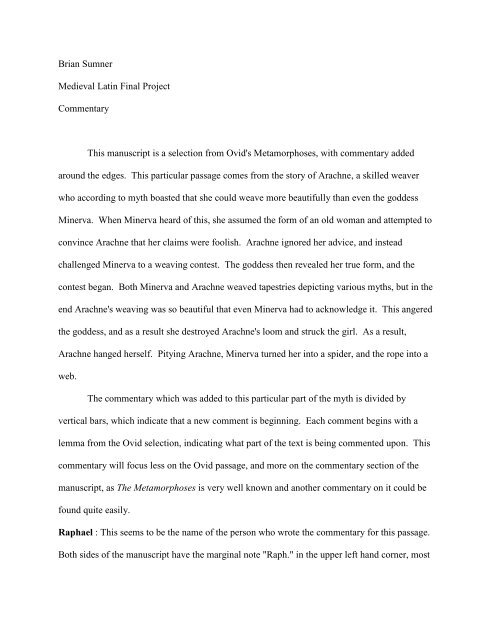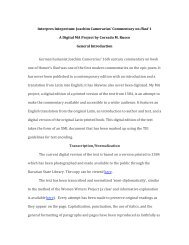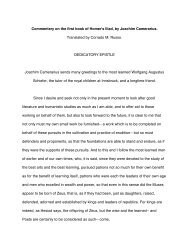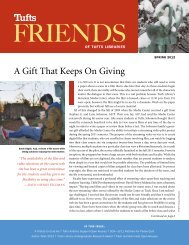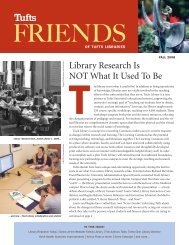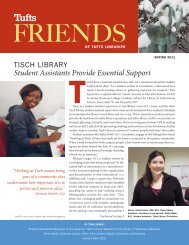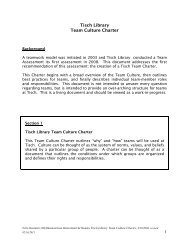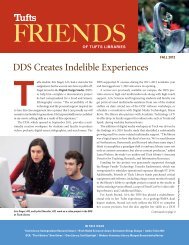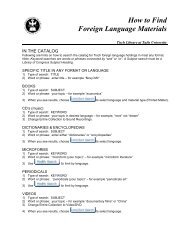Brian Sumner Medieval Latin Final Project Commentary This ...
Brian Sumner Medieval Latin Final Project Commentary This ...
Brian Sumner Medieval Latin Final Project Commentary This ...
You also want an ePaper? Increase the reach of your titles
YUMPU automatically turns print PDFs into web optimized ePapers that Google loves.
<strong>Brian</strong> <strong>Sumner</strong><strong>Medieval</strong> <strong>Latin</strong> <strong>Final</strong> <strong>Project</strong><strong>Commentary</strong><strong>This</strong> manuscript is a selection from Ovid's Metamorphoses, with commentary addedaround the edges. <strong>This</strong> particular passage comes from the story of Arachne, a skilled weaverwho according to myth boasted that she could weave more beautifully than even the goddessMinerva. When Minerva heard of this, she assumed the form of an old woman and attempted toconvince Arachne that her claims were foolish. Arachne ignored her advice, and insteadchallenged Minerva to a weaving contest. The goddess then revealed her true form, and thecontest began. Both Minerva and Arachne weaved tapestries depicting various myths, but in theend Arachne's weaving was so beautiful that even Minerva had to acknowledge it. <strong>This</strong> angeredthe goddess, and as a result she destroyed Arachne's loom and struck the girl. As a result,Arachne hanged herself. Pitying Arachne, Minerva turned her into a spider, and the rope into aweb.The commentary which was added to this particular part of the myth is divided byvertical bars, which indicate that a new comment is beginning. Each comment begins with alemma from the Ovid selection, indicating what part of the text is being commented upon. <strong>This</strong>commentary will focus less on the Ovid passage, and more on the commentary section of themanuscript, as The Metamorphoses is very well known and another commentary on it could befound quite easily.Raphael : <strong>This</strong> seems to be the name of the person who wrote the commentary for this passage.Both sides of the manuscript have the marginal note "Raph." in the upper left hand corner, most
likely to ensure Raphael was given credit for all his work. The reverse side of the manuscriptgives us his full name, Raphael Regius. Raphael Regius was a Venetian known for hisreputation as a Classical scholar. His commentary on Ovid's Metamorphoses was one of themost widely circulated versions of the poem in the sixteenth century.Deceptive: imitated: Much of the commentary seems to give alternate ways of interpreting aword Ovid used, either by explaining a phrase or giving an alternative <strong>Latin</strong> word which wasprobably more commonly used. <strong>This</strong> was most likely to assist those who were lessknowledgeable in <strong>Latin</strong> to translate the text, by clarifying those sections which would be mostdifficult for them. As a result a comment on a word is often simply a synonym for the wordchosen by Ovid, which can create some repetitive sounding translations.Mygdonia: The marginal notes of the manuscript serve as a sort of bookmark, indicating what isbeing commented on at that point and allowing one to find relevant comments more quicklybased on their relative positions in the passage from the Metamorphoses. The relevant commentprovides a small amount of information about Mygdonia, giving the reader some context for thissection of the myth.who seeing Pallas, except for one, Arachne: they adore the goddess: <strong>This</strong> section is ratherawkwardly translated in order to preserve the colon in this line. <strong>This</strong> particular comment onMygdonia contains many colons, which could imply that they were meant to be interpreted insome other way. <strong>This</strong> colon could also simply be a mistake by the writer. If the colon isignored, then we can give a much more intuitive translation of this line: "The women, except forArachne, upon seeing Pallas adore the goddess."
When Aurora is first moved: Aurora is the name of the goddess of dawn, and so is usuallyinterpreted to mean dawn. Ovid uses "Aurora" as such several times in The Metamorphoses, asdoes Vergil in The Aeneid.They call this the weft: The commentary here attempts to clarify some of the terms used byOvid, for those who have no experience working with a loom. Several other parts of the loomare similarly clarified here.the poet elegantly describes all things: "The poet" here refers to Ovid, and this comment seemsto be a compliment to him and his ability to make even the mundane task of weaving soundpoetic.the comb is an instrument of the weaver which is too well known to be described: <strong>This</strong>offers an explanation as to why Ovid does not feel the need to elaborate upon the comb hementions during his description of weaving: the comb was simply such a well known tool forweaving that there was no need to explain what it was. <strong>This</strong> could also be intended to indicatewhy there is only a brief mention of the comb in the commentary: it was also well known enoughin the commentator's time that he did not feel the need to explain it either.For Tyre... : <strong>This</strong> comment provides some geographical context for the city of Tyre, andmentions that it was well known for its purple dyes. The idea of Tyre as the source of purple dyeis also found in other ancient writings, such as The Aeneid.what it touches is the same: <strong>This</strong> comment is intended to clarify Ovid's description of theshading of the tapestries. The shades of colors used are so similar that if the two were placednext to each other, they would appear to be the same color. But if the two shades were separated,it would be clear that they were actually different. Ovid compares this to the changes in color ina rainbow.


